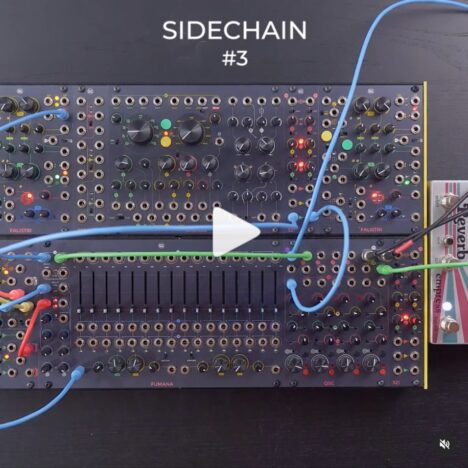- EURORACK
- CUNSA – Sound Seasoning
- CGM – Creative Mixer Series
- BRENSO – Entangled Sound Sources
- USTA – The Voltage Score
- FALISTRI – Movement Manager
- SAPÈL – Tamed Random Source
- FUMANA – Dual 16 Bands Spectral Editor
- 321 – Scale + Flip + Shift + Combine
- 333 – ProAudio Sum & Distribution
- SILTA 2016 – discontinued
- SEI – trunk lines – discontinued
- UNO – foldable case
- PLUS – modular modular case
- ACCESSORIES
- KNOBS
- 500 SERIES
- RESOURCES
- RESELLERS
- ABOUT
- ACCOUNT
Category / techniques
-
Audio-Rate USTA #1
We had to do it. Imagine if the oscillator becomes the clock and the sequencer becomes the oscillator. The question isn’t “why?”, but “why not?”
2022-07-05 -
Sidechain #3
Today we explored another way of using FUMANA’s ALL E.F. output. We used it to tame our reverb send and clear up the mix!
We took advantage of the 321 to scale, invert, and offset it, then patched the result to the QSC effect send.
That’s an easy way to avoid an overcrowded reverb tail!2022-07-05 -
Trills
Another popular embellishment is the trill, where you play a rapid succession of notes before or instead of a longer one.
To do so, we used FALISTRI’s force loop input: check out the trick in today’s Technique!2022-07-05 -
Grace Notes
Grace notes are notes that you play to ornate a melody. Every musical tradition has its own grace notes, so why should we modular players stay away from them?
In Western music you don’t write them as part of the melody: instead, you use tiny notes or symbols on top of it.
Since USTA is the Voltage Score, we want to stick with this concept!
In this Technique, we wrote a plain sequence and used a tiiiiny little envelope patched to the CV A input to add some grace notes here and there through pitch shifting. Happy experimenting!
2022-07-05 -
Ratcheting S&H
Sometimes you can think of USTA’s gate outputs as a modulation source rather than just a stream of impulses to fire some envelopes.
In this patch, we used them to clock SAPÈL’s yellow generator so that one new gate = one new random voltage. We also set the gates to the green color to create a denser rhythm on top of our melody.
2022-05-17 -
USTA Hold
An effortless technique for the USTA sequencer: while playing, hold Set All and push a CV or gate button while playing. It will keep the value played at that specific moment until you release it!
2022-05-17 -
Individual Outs #1
Time to use those 16 outputs up there! In this patch, we used some individual bands to feed a shimmer reverb, thus obtaining a different harmonic feel every time.
2022-05-17 -
FALISTRI Clock Manipulation #2
A variation on last week’s Technique: FALISTRI as a clock delay/clock divider controlled by USTA! The layout is the same: Track 1 runs at an internal clock; its gate B trigs…2022-02-24 -
FALISTRI Clock Manipulation #1
This time we used FALISTRI to play with USTA’s clock! We had our main track set to the internal clock, and then we used the gate B output to trig FALISTRI, whose…2022-02-24 -
Inverted V/Oct #2
Here's another cool trick to add some expressiveness to your lines with our 333 and 321: duplicate the V/oct signal, send a copy to the oscillator, and another to the 321. Then…2022-02-24
Categories
Recent Posts
- CUNSA v/s FUMANA: The same patch on two different filters!
- Subharmonic formant arpeggios patch breakdown: a classic Falistri patch!
- Memes aside, let’s make Sandstorm by Darude on our Frap Tools system
- Four tips to use CUNSA as a sound source (including ringing and additive synthesis)
- ‘Glass sounds‘ analog through-zero FM patch breakdown with Brenso and Cunsa!









